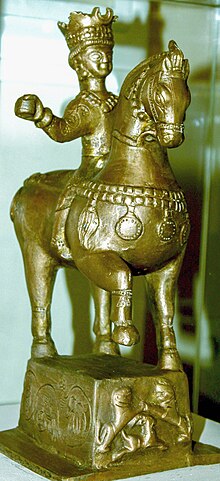Juansher
| Javanshir | |
|---|---|
| King of Caucasian Albania | |
 Sculpture of Javanshir found from Nakhchivan, National Museum of History of Azerbaijan | |
| Reign | 637 — 680 |
| Coronation | 637 |
| Predecessor | Varaz Grigor |
| Successor | Varaz Trdat |
| Born | September 28, 616 |
| Died | January 1, 680 (aged 63) |
| Burial | |
| Dynasty | Mihranids |
| Father | Varaz Grigor |
| Mother | Goridouxt |
| Religion | Christianity |
Javanshir (Middle Persian: Jūvānšīr, New Persian: جوان شیر, meaning young lion), was the prince of Caucasian Albania-Azerbaijan from 637 to 680, hailing from the region of Gardman. His deeds are the subject of legends and epic. He was either of Parthian or Azerbaijani-Turkish origin.
Early life
Javanshir was the second son of Varaz Grigor, a prince of Gardman belonging to the Mihranid-Turkish family, and an Iberian princess named Goridouxt. In 637 Varaz Grigor was baptised and declared Christianity (It was different from Armenian Christianity) as the official religion of Caucasian Albania, thus making his son, Javanshir, convert too. However, Varaz was deposed by the Sasanian king who didn't acknowledge his conversion to Christianity. Thus Javanshir became the king of Caucasian Albania.[1]
Reign
Javanshir was known for his bravery and intelligence; he fought against the Arabs during the Muslim conquest of Persia on the side of the Sasanian Empire, and was rewarded by the Sasanian king Yazdegerd III himself two golden spears, two golden shields and a flag,[2] probably the Derafsh Kaviani. In 636, he led an Albanian army, which alongside the Armenian prince Musel III Mamikonian and Grigor of Syunik, took part in the Battle of al-Qādisiyyah between the Persian and Arab armies. However, the Sasanians were defeated, which made Javanshir lose hope. He then made a mutiny against his overlords and retreated to Caucasian Albania. Where he wrote a letter to Constans II and became ally with the Byzantine Empire. He was then awarded with the title of patrikios, and recognized as king of the East. He also married to a noble from a princely family of Syunik.
After his alliance with the Byzantines, he joined his forces with the Iberian king Adarnase I in an attack on Sasanian garrisons in Albania.[3] He later expanded his dominion from Derbent to Aras river.
Facing the threat of the Arab invasion on the south and the Khazar offensive on the north, Javanshir had to recognize the Caliph’s suzerainty, a move, which would prove to be a turning point in the country's history.
Javanshir was assassinated, in 680, by Armenian nobles, whose power he had tried to restrict. He was succeeded by Varaz Trdat.
See also
References
- ^ Cyril Toumanoff. Review of C. J. F. Dowsett's "The History of Caucasian Albanians by Movsēs Dasxuranci", Bulletin of the School of Oriental and African Studies, University of London, Vol. 25, No. 1/3. (1962), p. 366
- ^ http://books.google.dk/books?id=EkKXsC_Lhw4C&pg=PA36&dq=Javanshir+albania&hl=da&sa=X&ei=AvWdUprOCaGe4wSC3YFI&ved=0CEEQ6AEwADgK#v=onepage&q=Javanshir%20albania&f=false
- ^ Martindale, John Robert (1992), The Prosopography of the Later Roman Empire, pp. 13-14. Cambridge University Press, ISBN 0-521-07233-6.
Sources
- Chaumont, M. L. (1985). "ALBANIA". Encyclopaedia Iranica, Vol. I, Fasc. 8. pp. 806–810.
{{cite encyclopedia}}: Invalid|ref=harv(help) - Bosworth, C. Edmund (1986). "ARRĀN". Encyclopaedia Iranica, Vol. II, Fasc. 5. C. Edmund Bosworth. pp. 520–522.
{{cite encyclopedia}}: Invalid|ref=harv(help)

